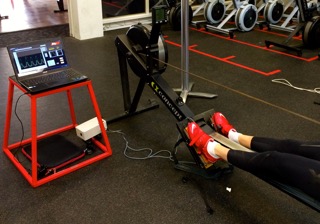Stability Equals Power
Your feet are your first and, power-wise, most important connection to the boat. Having some understanding for their function and how to support them is key to produce your most powerful stroke.
It would be be frustrating to learn that something as simple as the ankle flexibility you were born with, or acquired through an injury, would curse you with a disadvantage in rowing. This is especially so since our peripheral joint ‘function’ is rarely able to be altered in a significant way.
The ankle is a vital pivot point and load transferrer in the stroke. This was an early finding for our team who have since been considering the negative effects a poor ankle position and functionality can bring and what we can do about it. This R&D Note describes what happens at the lower limb during the stroke and begins to consider what we can change to alleviate some the problems identified.
We began analysing this problem by critically reviewing the equipment most athletes have been forced to use: a flat footboard fixed at around 40-42 degrees.This set-up provides a reasonable, whole-foot platform towards the finish of the stroke, but not at the catch or (for most athletes) up to the first 60% of the drive phase. Instead, when pushing off a standard foot stretcher at the catch, the athlete’s foot is in a flexed position, with weight being braced against a small area under the ball of the foot.

The picture on the right demonstrates a typical position immediately prior to the catch. As it shows, the heel has lifted between 30-40 degrees from the position it will be in at the finish (or between 4-8 centimetres depending on shoe size and ankle flexibility). What is interesting is that the degree of heel lift (and thus the foot area an athlete has to push against at the catch) is determined by ankle flexibility and stretcher position. Further, it is rarely the flexibility of the athletes achilles tendon which is the limiting factor in ankle flexibility, rather the point at which the bones of the shin and ankle ‘lock up’ and lift the heel during the recovery.
So, the ankle flexibility you were born with will determine what degree of heel lift you have, and the foot surface area you will be pushing off at the catch. We see the importance of this only when we then consider what happens during the rowing stroke when the foot is placed in this weak position. The immediate effect is that the arch of the foot collapses as pressure mounts on the foot. Further, postural (non-dynamic) muscle contractions are required as the body strives to hold the foot and lower limb in a position to maintain the power on the blade. As the force increases on the blade, further unnecessary stress is placed on the knees, lower back and shoulders in order to maintain a degree of stability.
At best this means wasted energy and muscles that are not recruited to apply power. At worst, we see a mechanism for injury inbuilt into our standard rowing equipment.We like to compare it to trying to do squats on your toes – you just won’t be lifting the amount of weight your muscles are capable of if your feet aren’t in a strong, supported position. This is shown when our data demonstrates that peak leg force is applied only when the foot has its maximal contact with the foot stretcher and that this can be boosted by added stability and surface area i.e. getting more of your foot on the stretcher during the drive.
Your feet are your first and, power-wise, most important connection to the boat. Having some understanding for their function and how to support them is key to produce your most powerful stroke.

